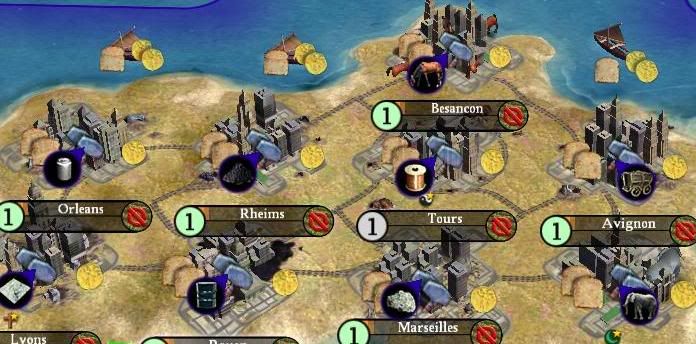The sites recommended by the AI's city-placement algorithm (shown by the blue circles to a player), emphasize getting as may resources in the city's workable radius as possible, with little consideration for FPC values. Since resources can be accessed outside your workable radius, but great FPC tiles cannot, I've found I can often place better cities without the computer's recommendations visible.
After all, the human mind excels at goal-oriented planning (choosing city sites based on what your plans are in the area), something that's very hard to code.
With resources, the things to consider are 1) your total FPC values, and 2) how soon you need access.
- Will your city get more total food, production and commerce building directly on the resource, or on another tile?
- Will you get more benefit from that +1 FPC bonus building on the resource right away, with immediate access to the resource, or will you get more benefit in the long term by building elsewhere?
In some cases, it's better to build on the resource, the other 90% of the time you usually won't. Here's an extraordinary example I encountered a few weeks ago:

Rivers count as trade routes, as a result my capital city had Stone immediately upon building my second city, without the need for roads or a quarry. This city also got an early double-hammer-production bonus (from 1 to 2). In this case it was beneficial, had it been my 10th city however, the 1 extra hammer and quicker access would not have been worth it.
If it was later in the game, I would have built the city 1 tile further south to gain access to the hill to the southwest, and a quarry for the stone.
This was possibly one of the best starting locations I've ever had

Some notes in the article:
- Forests also negate the +1 commerce from rivers (in addition to Jungles). Lumbermills remove this effect.
- For clarification, placing a city on a tile with "Fresh Water" in the tooltip gives +2 health. Fresh water tiles are adjacent to rivers, fresh water lakes, or an oasis. This is often less confusing than stating a city next to fresh water gets the health bonus, as many people interpret that as meaning within the city's workable radius, or next to a fresh water tile.
- Flood plains are actually included in your 1st picture, unmarked.







